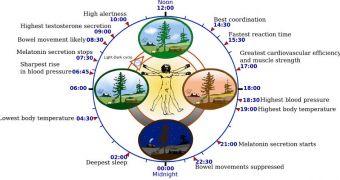Scientists have known for quite some time that our metabolism is regulated by the circadian rhythm, the human body's internal clock, but they didn't know what regulated the clock itself. A new study new sheds light on the mystery.
Investigators based at the UT Southwestern Medical Center reveal now that the circadian rhythm is in fact controlled by subtle variations in the body's internal temperature.
The research also sheds some more light into how the suprachiasmatic nucleus (SCN) controls all tissues and organs, in terms of their response to the night-day cycles.
The SCN is a portion of the human brain that has been dubbed the body's “master clock,” and which is responsible for coordinating the circadian cycle indirectly, Science Blog reveals.
Previous studies have shown that this area of the cortex responds to light signals entering the eye. This information is then transformed into electrical signals, which travel through neurons, and eventually dictate the inner temperature of the body.
The UT Southwestern team notes in the October 15 issue of the top journal Science that these cyclic fluctuations are largely responsible for the way tissues and organs respond to the night-day cycle.
“Small changes in body temperature can send a powerful signal to the clocks in our bodies,” explains Howard Hughes Medical Institute investigator Dr. Joseph Takahashi.
The expert also holds an appointment as the chairman of neuroscience at UT Southwestern, and he was the senior author of the new research paper.
“It takes only a small change in internal body temperature to synchronize cellular ‘clocks’ throughout the body,” the scientist goes on to say.
“Circadian rhythms in plants, simple organisms and cold-blooded animals are very sensitive to temperature, so it makes sense that over the course of evolution, this primordial mechanism could have been modified in warm-blooded animals,” he argues further.
In other words, this mechanism may be a vestigial remain from an ancient control pathway that may have developed in earlier animals, including in cold-blooded creatures.
Crocodiles and snakes are susceptible to temperature stimuli coming from their exterior, as they are unable to produce heat all on their own.
The new research effort was made possible by grants from the US National Institutes of Health (NIH) and the HHMI.

 14 DAY TRIAL //
14 DAY TRIAL //